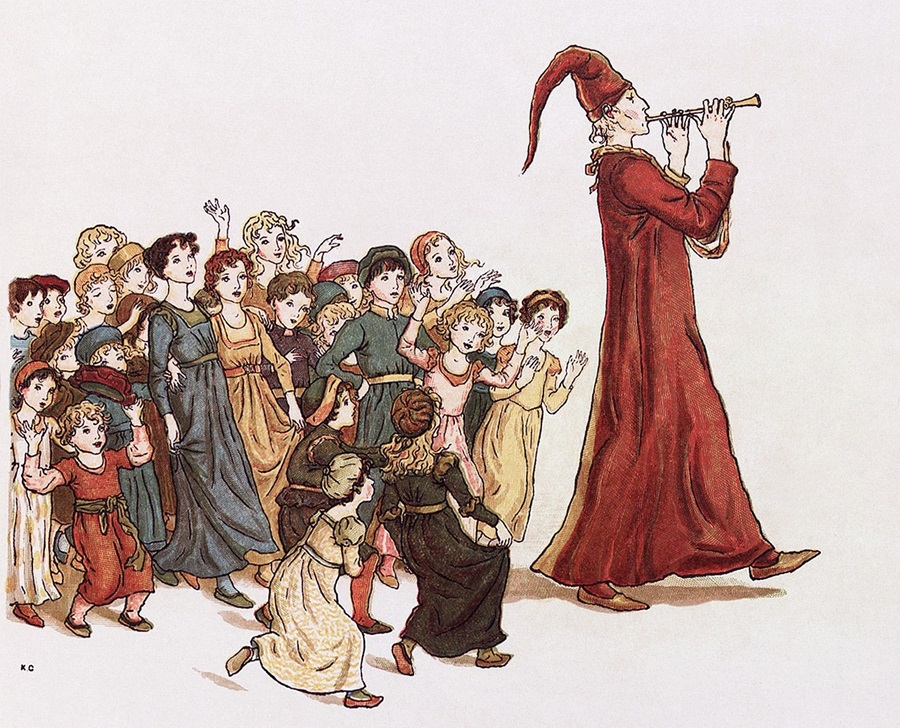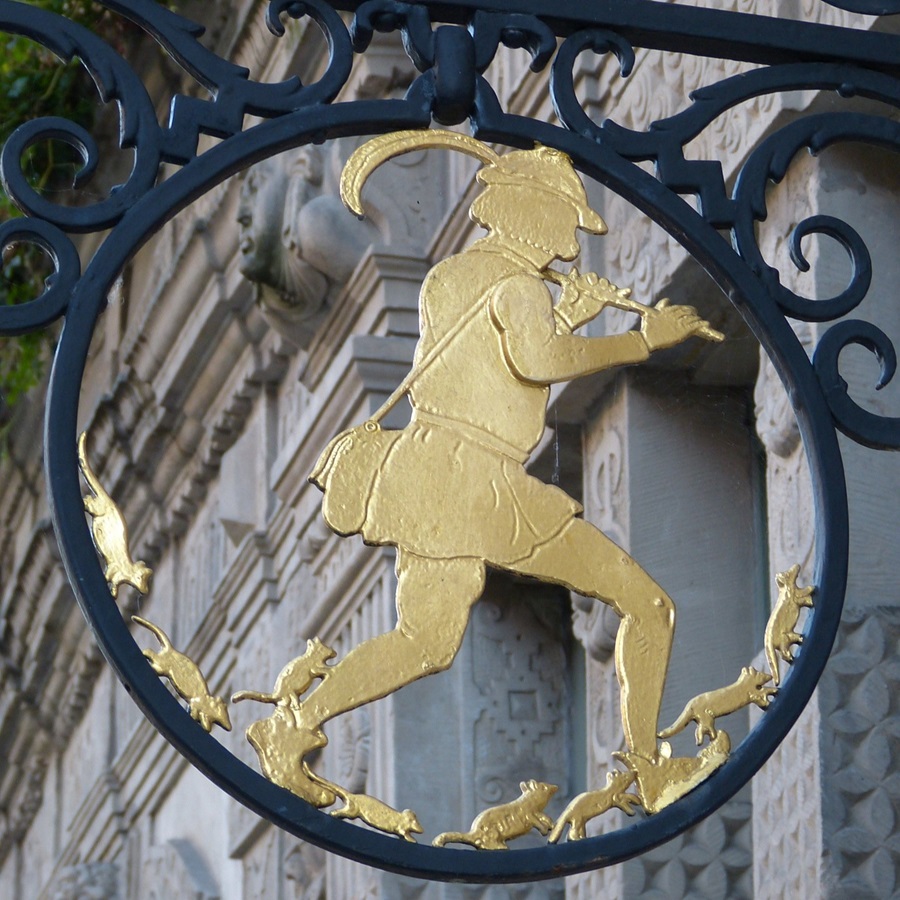In honor of Halloween, it seems like a fitting time to explore one of the darkest fairy tales that still has readers guessing: the Pied Piper of Hamelin (also Hameln). There are many versions of this story from several countries, but the most famous rendition hales from the actual town of Hamelin, Germany.
While most fairy tales originate from real places, the Pied Piper is uniquely specific. The concept of a mysterious man kidnapping an entire town of children is haunting all on its own. But did you know that the Pied Piper is based on a historical event? An event that took place on a specific date? The exact details of the story are unknown, so it’s impossible to know just how literal this story might be. But once you go down the rabbit hole of all the theories that historians have uncovered, the Pied Piper is one of the most chilling fairy tale figures you could imagine.
The Original Version of the Pied Piper
So. Who first recorded the story of the man with the pipe? Perhaps the earliest version on record is a ballad by Johann Wolfgang von Goethe, one of the most influential German writers in history. But as per usual, the most well-known version of the Pied Piper with the best translations is the Grimm Brothers’ version, which was heavily inspired by Goethe’s writings.
The story is set in Hamelin, Germany, in the year 1284. Apparently this town is suffering a rat problem until one day when a strange man comes to Hamelin. He calls himself the Pied Piper, so named because of the multi-colored “pied” coat that he wears. The man claims to be a rat-catcher who can rid Hamelin of all vermin—for a price of course. The citizens agree to the cost immediately. Then the Pied Piper pulls a fife out of his pocket and plays a song that attracts every last rat and mouse in town. The Piper leads all the vermin through the streets to the River Weser on the edge of Hamelin. There, all the unfortunate rodents drown, solving the infestation within the hour.

Then Comes the Subject of Payment
The townspeople are overjoyed that their rat troubles are over until the Piper asks for his promised reward. Instantly the townsfolk regret promising so much money. Maybe they thought it would take more time and effort for this rat-catcher to make good on his word. The people of Hamelin refuse to pay, a choice that seems risky to me considering the Piper’s magical powers. But the Pied Piper leaves town, unpaid and bitterly angry.
His absence is short lived. On June 26, Saint John’s and Saint Paul’s Day for Roman Catholics, the Pied Piper returns to Hamelin. Now dressed in hunting clothes and a “strange red hat,” the Piper plays his fife again. But instead of attracting rodents, his song lures all the children of Hamelin. The Pied Piper leads one hundred and thirty kids straight out of town and into the mountain where they are never seen again.
The Grimms mention that three children were spared from the Piper: a blind child who couldn’t follow the others, a mute child who couldn’t hear the pipe, and another little boy who turned back to town for his forgotten jacket. What became of the other children, no one knows. Some say the Piper led them to a cave in the mountains and then to Transylvania. But the one hundred and thirty never returned to Hamelin, and all the mothers mourned. To this day, no one is permitted to dance or play music on the road where Hamelin’s children were taken.

Apparently This Story Is More Legend than Fairy Tale . . .
The Grimms include a few fascinating details of the Pied Piper story that harken back to the real Hamelin. The event of the lost children was so significant that the townspeople began dating all their proclamations by the number of years and days since June 26, 1284. In 1572, the town portrayed the tragic event in a famous stained-glass window on their church, as well as several inscriptions written on landmarks in town. The most famous is on the town hall:
In the year 1284 after the birth of Christ
From Hameln were led away
One hundred thirty children, born at this place
Led away by a piper into a mountain.
You can find and read all of these inscriptions today in Hamelin, Germany. Although the original stained-glass window was destroyed, artwork of the original window exists to bear record of it. And the building known as the Pied Piper House has a plaque that reads,
A.D. 1284 – on the 26th of June – the day of St John and St Paul – 130 children – born in Hamelin – were led out of the town by a piper wearing multicolored clothes. After passing the Calvary near the Koppenberg they disappeared forever.
Ongoing Speculation about the Pied Piper
Just a few decades after the Grimms recorded the Pied Piper story, English poet Robert Browning wrote a famous adaptation called “The Pied Piper of Hamelin.” The poem adds a lot more artistic detail to the story, and of course it reinvigorated interest in the Pied Piper.
Today, the fairy tale is told in 42 countries and 30 languages, but there are still many conflicting theories about the historical event that inspired the story. Clearly something awful happened to the children of Hamelin. An event traumatic enough that even the walls of the city bear record of it. Historians can’t quite agree since the details have been lost in the sands of time, but let’s chat about the going theories.

The Most Widely Accepted Theory Is Migration
The year 1284 when the Pied Piper visited Hamelin coincides with widespread economic depression in Germany that triggered major migration events. In that time, men called locators or recruiters wore brightly colored clothing and played instruments similar to the Pied Piper’s fife. This music invited the attention of nearby towns to convince young pilgrims to migrate. The theory is that the “children of Hamelin” weren’t just children. They were townspeople of all ages who chose to leave. It’s possible they traveled to another part of Germany, to Eastern Europe, or perhaps to Transylvania as the Grimms suggested. Wherever they went, they did not return.
This is the most plausible historical guess of what happened in Hamelin. The migration theory may not be as exciting as many are hoping for, but trust me, the theories get darker . . .
Another Possibility: The Pied Piper Symbolizes Death
Some believe that the lost children didn’t simply walk out of town. They died.
Of course the year 1284 was too early for the Black Death to be involved. That didn’t rage through Europe until the mid-1300s, but it’s easy to see the connection between the rats and the Plague. Then again, Hamelin’s plague of rats is a new addition to the Pied Piper story. The earliest versions of the tale didn’t include rats at all, so it’s plausible that the rat infestation of Hamelin and the one hundred and thirty lost children were two separate events melded into one fairy tale from the same place.

Even if the Black Death wasn’t to blame, this was the medieval ages. Sickness happened all the time, and people had a much shorter lifespan in the 1200s. Long before the Black Death came around, people lived in fear of illness and losing children far too young. Hamelin could have experienced a pandemic event in 1284. Some historians believe it might have been an outbreak of dancing plague—a.k.a. choreomania—which hit Germany in the thirteenth century. This disease caused muscle spasms that made victims twitch and dance for hours or days until some developed permanent tremors or even died of exhaustion. It’s possible that one hundred and thirty residents of Hamelin died from choreomania—an illness that forced them to dance to the hallucinatory music of “The Piper.” Creepy.
But What About the Incredibly Specific Date?
These theories about migration or mass sickness don’t seem to jive with the known detail that whatever happened, it was on June 26, 1284. So what do we know about that date? June 26 happens to be a religious holiday celebrating two martyred saints, and like most religious holidays, this date marked a pagan holiday first. June 26 is the time for midsummer festivals, a pagan practice of celebrating the summer solstice with drinking, dancing, and bonfires in the hills outside of town—the exact place where the Pied Piper led the children of Hamelin.
With that context, it’s possible that this piper led a group of young people out of town to a midsummer celebration. One that the local Christians probably did not approve of. Could the children have been massacred for upholding pagan tradition? Or died suddenly due to a disaster or other kind of attack? We can only speculate, but their disappearance on that specific date can’t be ignored.
We May Never Know Exactly Who the Pied Piper Was
Perhaps the Piper was just a migration recruiter or a figurative embodiment of death. But what if the Piper was a real and specific person? What if he was a charismatic figure who lured the children away? Some of the more sinister theories about the Pied Piper take several different directions.
Some believe he could have been a military leader who led away the youth of Hamelin on a children’s crusade to the Holy Land. A battle from which they would never return. Another theory is that the Pied Piper was some sort of pedophile who led the children to the mountain for the worst of reasons. Whether he promised them frivolity or freedom from their normal lives in Hamelin is unclear. But we can certainly tell from the story that he was a persuasive figure if nothing else. Maybe the pipe he played was a literal pipe, promising amusement, music, and joy. Maybe the pipe is only symbolic of his persuasive words, cunning plans, or false promises. Or maybe he really was a magician who hypnotized one hundred and thirty children to their doom for unknown reasons.

Regardless of who the Piper was or what he promised, it’s clear that the loss of so many young ones was a deeply traumatic event for the town of Hamelin. Why else would such an event be branded into the centuries-old memory and identity of this town? Losing nearly all of their children clearly changed Hamelin forever, even if we’ll never know how it happened.
Still, the Moral is Clear: Always Pay the Piper
The artistic renditions of the tale of Hamelin have added a clear moral component to this story. It’s common for fairy tales to explore the gray area of human morality, but they just as often introduce a simple black-and-white dichotomy to soften tragic events. After all, bad decisions that lead to tragedy can be avoided in the future, right? At least the oral history of Hamelin has chosen to honor their lost children by remembering to always pay their debts, always keep promises, and always tell the truth. Honestly, that isn’t bad advice. ❧




